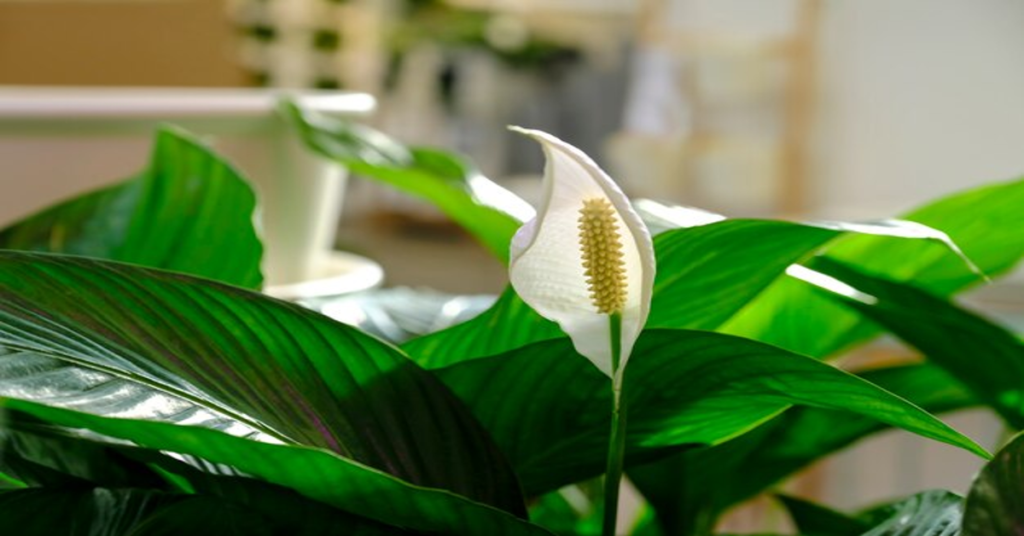Among indoor plants, the Spathiphyllum, commonly known as the peace lily, is one of the most popular and beloved choices for home and office décor. Its elegant white flowers, glossy green leaves, and ease of care make it an ideal plant for both beginners and seasoned plant enthusiasts. The peace lily is known for its striking aesthetic appeal, air-purifying qualities, and its ability to thrive in low light conditions, making it a perfect addition to various indoor environments.
In this article, we will explore the many facets of the Spathiphyllum plant, covering its history, types, care requirements, health benefits, and how to incorporate it into your living space. We will also provide a detailed breakdown of its care and maintenance to ensure your peace lily stays healthy and vibrant.
What is Spathiphyllum (Peace Lily)?
Spathiphyllum is a genus of flowering plants in the family Araceae, native to tropical regions of the Americas and Southeast Asia. The plant’s most common species, Spathiphyllum cochlearispathum, is widely known as the peace lily. It is characterized by its attractive white blooms and glossy, dark green foliage. Despite its name, the peace lily is not actually a true lily (Lilium). It is called a “lily” due to its resemblance to traditional lilies, especially the white, trumpet-shaped flowers.
The plant’s striking appearance and air-purifying properties have made it a popular choice for indoor gardening, and it’s commonly found in homes, offices, hospitals, and public spaces. One of the most unique characteristics of the peace lily is its ability to thrive in low-light conditions, making it perfect for spaces where other plants might struggle.
The History and Symbolism of Spathiphyllum
The peace lily’s association with peace and tranquility goes back centuries. The plant is often linked with peace due to its name, as the word “spathiphyllum” is derived from the Greek words “spath,” meaning “spoon,” and “phyllon,” meaning “leaf,” referring to the shape of its white flower spathes.
In many cultures, the peace lily is seen as a symbol of purity, peace, and renewal. It is often used in ceremonial settings, like funerals and memorial services, as a way of honoring loved ones and symbolizing the peaceful transition to the afterlife. The peaceful connotations of the plant have made it a popular gift in situations where a calming or peaceful gesture is desired.
Types of Spathiphyllum
There are several species and varieties of Spathiphyllum, each with its own unique characteristics. While the peace lily is commonly associated with one primary type, there are many variations that differ in size, flower shape, and leaf color. Here are some of the most popular types of Spathiphyllum:
1. Spathiphyllum cochlearispathum (Common Peace Lily)
This is the most common type of peace lily and is recognized for its large white blooms and long, glossy green leaves. It is easy to grow and is often found in homes, offices, and public spaces. The plant can reach heights of 3 feet or more and produces flowers that are white with a yellow spadix at the center.
2. Spathiphyllum ‘Domino’
The Domino variety of peace lily features white and green mottled leaves, making it an eye-catching alternative to the more traditional green-leafed peace lilies. This variety is well-suited for smaller spaces due to its compact size, usually reaching about 1-2 feet in height.
3. Spathiphyllum ‘Mauna Loa’
The Mauna Loa variety of peace lily is known for its large, glossy, dark green leaves and towering white blooms. This variety can grow up to 4 feet tall, making it one of the larger varieties of peace lily. Its impressive flowers and lush foliage make it a stunning addition to any indoor space.
4. Spathiphyllum ‘Sweet Chico’
This variety of peace lily is much smaller, with a more compact growth habit. It produces smaller, delicate white flowers and is often chosen for tight spaces like office desks or shelves. Sweet Chico is ideal for those who want the benefits of a peace lily but have limited room for a larger plant.
5. Spathiphyllum ‘Wallisii’
Wallisii is a dwarf variety of peace lily with deep green, glossy leaves and white spathes. This compact plant typically reaches a height of about 12-18 inches, making it perfect for windowsills, smaller containers, or places with limited space.
Benefits of Spathiphyllum (Peace Lily)
The peace lily is much more than just a decorative plant. It offers a variety of health and environmental benefits that make it an excellent choice for indoor spaces.
1. Air Purification
One of the most well-known benefits of the peace lily is its ability to purify the air. According to NASA’s Clean Air Study, peace lilies are among the top plants for removing toxins from the air. They can filter out harmful chemicals such as formaldehyde, benzene, trichloroethylene, and xylene. By absorbing these pollutants and converting them into oxygen, the peace lily can improve indoor air quality, which is particularly beneficial in areas with poor ventilation or high levels of pollution.
2. Improved Humidity
Peace lilies also contribute to improving humidity levels in your home. As they transpire moisture through their leaves, they naturally increase the humidity in the air, which can be beneficial for people suffering from dry skin, respiratory issues, or allergies.
3. Aesthetic Appeal
With their striking white flowers and glossy green leaves, peace lilies add a touch of elegance to any space. Whether placed on a coffee table, office desk, or windowsill, their graceful appearance enhances the overall aesthetic of your home or workspace. Their ability to thrive in low-light conditions makes them perfect for rooms with limited natural light.
4. Low Maintenance
Peace lilies are known for being low-maintenance plants, making them an ideal choice for beginners or people with busy lifestyles. They don’t require a lot of attention or frequent watering. As long as you provide them with a bit of sunlight, the occasional water, and a well-drained pot, they’ll thrive and bloom year-round.
How to Care for Spathiphyllum (Peace Lily)
While peace lilies are relatively low-maintenance, they do have specific care requirements that need to be met in order for them to thrive. Below is a comprehensive guide to caring for your peace lily, covering watering, lighting, temperature, and other important aspects.
1. Lighting Requirements
Peace lilies prefer indirect sunlight, making them ideal for areas with low or medium light. They can tolerate lower light conditions, but they won’t bloom as frequently in these environments. If you want to encourage more blooms, place your peace lily in a spot that receives bright, indirect sunlight. Avoid direct sunlight, as it can scorch the leaves and cause damage to the plant.
2. Watering Needs
Peace lilies prefer consistently moist soil, but they do not like to sit in water. The best practice is to water the plant thoroughly when the top 1-2 inches of soil feel dry to the touch. Water the plant until excess water begins to drain from the bottom of the pot, but avoid allowing the plant to sit in standing water, as this can lead to root rot.
It’s also important to note that peace lilies are sensitive to chlorine and fluoride in tap water. If possible, use distilled or rainwater for watering, or let tap water sit for 24 hours to allow the chemicals to dissipate before using it on the plant.
3. Temperature and Humidity
Peace lilies thrive in warm, humid environments. The ideal temperature for a peace lily is between 65°F (18°C) and 80°F (27°C). Avoid placing the plant in areas with cold drafts or in rooms that experience drastic temperature fluctuations, as this can stress the plant and hinder its growth.
If you live in a dry climate, you may want to place your peace lily on a humidity tray or mist it occasionally to maintain the necessary moisture levels in the air.
4. Fertilizing
During the growing season (spring and summer), peace lilies benefit from regular fertilization. Use a balanced, water-soluble fertilizer, diluted to half strength, and feed the plant once a month. Avoid fertilizing during the dormant period (fall and winter), as the plant doesn’t need as much nutrition during this time.
5. Repotting
Peace lilies should be repotted every 1-2 years to refresh the soil and promote healthy growth. Choose a pot that is 1-2 inches larger in diameter than the current one to give the plant enough space to grow. Be sure to use well-draining potting soil and ensure the pot has drainage holes to prevent water from accumulating at the bottom.
6. Pruning and Deadheading
To maintain a tidy appearance and encourage new blooms, remove any dead or yellowing leaves and spent flowers from your peace lily. Use clean, sharp scissors or pruning shears to cut off dead growth, which will help the plant focus its energy on producing new leaves and flowers.
Common Problems and Solutions for Spathiphyllum
While peace lilies are generally easy to care for, they can sometimes experience problems. Here are some common issues and solutions:
1. Yellowing Leaves
Yellow leaves are often a sign of overwatering, under-watering, or exposure to too much direct sunlight. Check the soil moisture and adjust your watering schedule accordingly. If the plant is receiving too much sunlight, move it to a location with indirect light.
2. Brown Tips on Leaves
Brown tips can indicate underwatering, low humidity, or fluoride sensitivity. Ensure that the plant receives adequate water, and consider using a humidity tray or misting the leaves to improve moisture levels in dry conditions.
3. No Flowers
If your peace lily is not blooming, it could be due to low light or improper watering. Ensure the plant is receiving enough indirect light and is being watered properly. Peace lilies typically bloom in the spring and summer, but they may need some time to adjust before flowering.
4. Pests
While peace lilies are generally pest-resistant, they can occasionally attract pests such as spider mites or mealybugs. If you notice any pests, wipe down the leaves with a damp cloth or use an insecticidal soap to treat the plant.
Conclusion
The Spathiphyllum, or peace lily, is a versatile and low-maintenance plant that brings beauty, tranquility, and numerous benefits to any indoor space. With its air-purifying qualities, ability to thrive in low light, and elegant appearance, the peace lily is a favorite for both new and experienced plant owners. By following the proper care guidelines, your peace lily will continue to thrive, adding a sense of peace and calm to your home or office.
FAQs
- How often should I water my Spathiphyllum (peace lily)? Water your peace lily when the top 1-2 inches of soil feel dry to the touch, but avoid overwatering.
- Does a peace lily need direct sunlight? Peace lilies prefer bright, indirect sunlight and can tolerate low light conditions, but they may not bloom in such environments.
- Why are the leaves of my peace lily turning yellow? Yellow leaves can be caused by overwatering, underwatering, or too much direct sunlight. Adjust watering and light conditions accordingly.
- How do I encourage my peace lily to bloom? Ensure it receives bright, indirect sunlight, and water it properly. Fertilize during the growing season and maintain a warm, humid environment.
- Is the peace lily toxic to pets? Yes, peace lilies are toxic to pets (cats and dogs) if ingested. Keep the plant out of reach of pets.
- How do I prune my peace lily? Prune dead or yellowing leaves and spent flowers using clean, sharp scissors to encourage new growth and maintain a tidy appearance.







